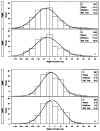Military services fitness database: development of a computerized physical fitness and weight management database for the U.S. Army
- PMID: 19216292
- PMCID: PMC2761744
- DOI: 10.7205/milmed-d-03-7807
Military services fitness database: development of a computerized physical fitness and weight management database for the U.S. Army
Abstract
The Department of Defense (DoD) has mandated development of a system to collect and manage data on the weight, percent body fat (%BF), and fitness of all military personnel. This project aimed to (1) develop a computerized weight and fitness database to track individuals and Army units over time allowing cross-sectional and longitudinal evaluations and (2) test the computerized system for feasibility and integrity of data collection over several years of usage. The computer application, the Military Services Fitness Database (MSFD), was designed for (1) storage and tracking of data related to height, weight, %BF for the Army Weight Control Program (AWCP) and Army Physical Fitness Test (APFT) scores and (2) generation of reports using these data. A 2.5-year pilot test of the MSFD indicated that it monitors population and individual trends of changing body weight, %BF, and fitness in a military population.
Figures







References
-
- Department of Defense Instruction 1308.3. DoD Physical Fitness and Body Fat Programs Procedures. Washington, DC: Government Printing Office; 2002.
-
- Singer B, Palmer B, Rogers B, Smith J. Military Services Physical Fitness and Weight Management Database: A Review and Analysis, O. Wright-Patterson Air Force Base. OH: Human Systems IAC; 2002.
-
- US Army. Army Regulation 600-9. Washington, DC: U.S. Government Printing Office; 2006. The Army Weight Control Program.
-
- Vogel JA, Kirkpatrick JW, Fitzgerald PI, Hodgdon JA, Harman EA. Derivation of anthropometry based body fat equations for the Army’s weight control program. U.S. Army Research Institute of Environmental Medicine; Natick, MA: 1988. Technical Report T17–88.
-
- Friedl KE. Can you be large and not obese? The distinction between body weight, body fat, and abdominal fat in occupational standards. Diabetes Technol Ther. 2004;6:732–49. - PubMed
Publication types
MeSH terms
Grants and funding
LinkOut - more resources
Full Text Sources
Medical
Miscellaneous

